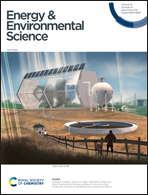Ultrafine-grained Ni-rich layered cathode for advanced Li-ion batteries†
Abstract
The development of high energy-density Ni-rich (Ni ≥ 90%) layered cathodes has remained difficult because of the rapid capacity fading that occurs during cycling. This study demonstrates that limiting the primary particle size of the cathode resolves the capacity fading problem as nano-sized primary particles effectively relieve the high internal strain associated with the phase transition near charge end and fracture-toughen the cathode. A linear relationship is observed between battery cycling stability and cathode primary particle size. The introduction of Mo inhibits the growth/consolidation of primary particles and limits their size to a submicrometer scale thus improving the cycle life of Li[Ni0.95Co0.04Mo0.01]O2 to a commercially viable level. The Li[Ni0.95Co0.04Mo0.01]O2 cathode, whose microstructure is engineered to mitigate the mechanical instability of Ni-rich layered cathodes, represents a next-generation high energy-density cathode with fast charging capability for electric vehicles with a material cost advantage over current commercial cathodes as Co, a relatively expensive and increasingly scarce resource, is replaced with Ni without compromising battery capacity and battery life.



 Please wait while we load your content...
Please wait while we load your content...